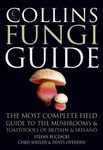About this book
Language: English with bilingual summary in English and German
Fungi of Cameroon is a contribution towards assessing the current macrofungal diversity associated with the ecosystems of Cameroon's southern forests, and evaluates the impact of deforestation and slash-and-burn on fungal communities and tracks the occurrence and changes to the fungal communities through the seasonal climatic variations (rainfall).
During three forays in different seasons, more than seven-hundred fungal samples were collected, all of which are described and characterised. 78% of these were basidiomycetes, while ascomycetes accounted for 21% of the samples. The identification of about 85% of all collected specimens with modern mycotaxonomic techniques has yielded a total of 271 distinct species, belonging to 110 genera in 58 families. Fungi of Cameroon provides compiled keys at the family, genus and species level, followed by micro- and macromorphological descriptions of different taxa, providing data on habitat, local and worldwide distribution where available. A full description is provided fore each species, supported by reliable line-drawings and often SEM images for ornamented basidiospores.
The overall recorded species were new to the Mbalmayo forest reserve, while 75 of the described species were new to Cameroon, and eleven new mycobiota were described, plus one combination. The greatest fungal diversity was observed in forest stands, declining towards fallows and cropland. A distinct reduction of the diversity of wood and litter-dependent fungal species can be observed where land conversion takes place which is a definite threat to fungal species. As expected, seasonal variations fundamentally influence and govern the fruition and composition of the fungal communities studied.
Contents
Acronyms And Abbreviations viii
I General Introduction 3
1 Thesis research overview 3
2 Historical overview on the study of Cameroon mycoflora 4
3.1 Outline of physical settings 8
3.1.1 Geography and relief 8
3.1.2 Climate 8
3.1.3 Vegetation 8
3.2 Local communities, land use and socio-economic activities 12
II Collecting of Edible Mushrooms and Ethnomycology in the Mbalmayo Forest Reserve 14
1 Introduction 14
2 Methodology 14
3 Results and comments 15
III Ecology and Phenological Patterns of Macrofungi in the Mbalmayo Forest Reserve 19
1 Introduction 19
2 Material and Methods 19
2.1 Material 19
2.2 Methods 19
2.2.1 Collecting sites and sampling design 19
2.2.2 Survey methods, treatment and preservation of specimens 21
2.2.3 Data analysis 22
3 Diversity and ecology of macrofungi communities 22
3.1 Saprotrophic lignocellulolytic fungi on litter and woody substrata 22
3.2 Saprotrophic terricolous and saprotrophic humicolous fungi 25
3.3. Phenicoid species 27
3.4 Seminicolous species 29
3.5 Diversity of mycorrhizal species 29
4 Fungal diversity and forest disturbance 30
4.1 Introduction 30
4.2 Results 30
4.3 Discussion 32
5 Macrofungi diversity and seasonal variation 34
5.1 Results 34
5.2 Discussion 34
IV Taxonomic Studies Of Non-gilled Hymenomycetes 39
1 Introduction 39
2 Methods 42
2.1 Description of macromorphological characters 42
2.1.1 Development and shape of basidiomata 43
2.1.2 Size and colour 43
2.1.3 Basidiomata cover and consistency 44
2.1.4 Hymenophore and basidiospore bearing surface 45
2.2 Study of micromorphological characters 45
2.2.1 Chemical reagents and histological reactions 45
2.2.2 Microscopic preparations 46
2.2.3 Light microscopy and line drawings 47
2.2.4 Scanning Electron Microscopy (SEM) 47
2.2.5 Relevant microscopic characters 47
2.2.5.1 Hyphae and hyphal system 47
2.2.5.1.1 Generative hyphae 47
2.2.5.1.2 Vegetative hyphae 49
2.2.5.2 Sterile structures 50
2.2.5.2.1 Cystidia and allied elements 50
2.2.5.2.2 Setal elements and gloeocystidia 50
2.2.5.3 Basidia 52
2.2.5.4 Asexual spores 55
2.2.5.4.1 Chlamydospores 55
2.2.5.4.2 Conidia 55
2.2.5.4.3 Hyphal pegs 55
2.3 Identification with aid of molecular data 57
3 Taxonomic part 59
3.1 Keys 59
3.1.1 Key to groups 59
3.1.2 Key to families 59
3.1.3 Key to genera 62
3.2 Gasteromycetes 67
3.3 Heterobasidiomycetes 85
3.4 Aphyllophorales 100
3.4.1 Clavarioid fungi 100
3.4.2 Stereoid fungi 123
3.4.2.1 Stipitate stereoid fungi 123
3.4.2.2 Non-stipitate stereoid fungi 150
3.4.3 Schizophylloid fungi 162
3.4.4 Polyporales 164
3.4.4.1 Lentinoid fungi 164
3.4.4.2 Ganodermataceae 184
3.4.4.3 Hymenochaetaceae 197
3.4.4.4 Polyporaceae and allied families 224
3.5 Systematic and geographical distributions of described species 349
V. Comparison of Macrofungal Flora in Main Explored Areas of Cameroon Forests 351
VI Discussion and Conclusion 356
1 General discussion 356
1.1 Macrofungal survey aftermath in ethnomycology and fungal knowledge of tribal peoples 356
1.2 Macrofungi monitoring in forested areas and choice of sampling protocol 356
1.3 High indexation of macrofungal richness and diversity to physical settings 358
1.4 Technical hurdles spelling out the relinquishment in surveying some African fungal groups 360
1.5 Overcoming the shortage of local illustrated literature on mycoflora 361
1.6 Controversial contribution of molecular methods to taxonomy 361
2 Conclusion and future challenges 369
Summary 370
Zusammenfassung 374
References 380
Index to Generic and Specific Names of Fungi 393
Index to Plant Names 410
Customer Reviews











![Die Gattung Hyphodontia John Eriksson [The Genus Hyphodontia John Eriksson]](http://mediacdn.nhbs.com/jackets/jackets_resizer_medium/59/59441.jpg?height=150&width=93)


























